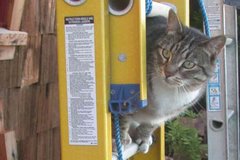Our first core: CAS16-01PC
The official CASEIS Cruise Blog is located here: http://www.ipgp.fr/caseis This official blog is written by my shift-mate Lola Johannes.
The first series of business today was the safety meeting. Safety First! We watched a presentation, went to try on the survival suits, and then learned how to get into the survival boats.
- Then we toured the bridge and Nathalie and Guillaume got a chance to sit in the Captain's chairs.
- Here is the inside of the survival boat, which is stocked with water and food I probably cannot eat, along with a large supply of lovely smelling diesel (which will keep us alive, so I would not complain about it)
- Here is Lulu editing the multibeam data. I introduced myself and told her I have done this too. Later we met and talked more. I learned some French from her. Basically, we use sonar to estimate the depth of the seafloor assuming something about the velocity of sound in water. We use sound velocity profiles to correct for this. After the raw data are collected, corrected for the ship's position and movement, they need to be edited to remove outliers. This is tedious but very important work.
- Here I am observing them place the core in the water for the first time! There is a piston core and a trigger weight. When the trigger hits the seafloor, the latch that holds the piston corer above the seafloor lets go. There is a weight of about 4,000 kg on the top of the piston core and when it hits the seafloor is pushes in with several hundred thousand foot pounds of force.
- Here is a pano from the fantail.
- Here, the trigger weight is connected to the trigger arm (the white bar angled down away from the main core and weight stand). They are just about to lower this corer into the water. We are all very excited! Captain Phillipe is also here to see that everything goes smoothly. He is very interested in the success for this cruise and the science crew has lots of confidence that he supports our work.
- We were quite successful today! The Calypso piston corer can collect cores with up to three 12 m sections (36 m). We chose to use 1 - 12 m section to begin with. The core deployed efficiently.
- While the core assembly was being prepared, my shift (4-8 PM) prepared the lab to process the cores once they come up to the ship. We constructed core holders to place the cores in when they are (1) being described and (2) sitting around waiting to be analyzed or stored in cardboard in boxes. We did not have enough materials for the core holders, but the ship's crew, the engineers, let us use some wood collected from pallets to construct these important devices.

The general core curation process is as follows (much is similar to how we do this on the cruises that I have participated on (R/V Roger Revelle and R/V Tommy G. Thompson):
- The liner comes out of the core barrel (the engineers do this).
- We cut the top of the core close to where the top of the sediment is and cap it.
- We rinse the core line and dry it off; then label it with markers.
- We then cut the core in 1.5 m sections, capping the ends as we go.
- The cores then get stored for 12 hrs to acclimate to the temperature.
- The core section are then scanned using a multi core sensing logger (MSCL, made by GEOTEK) to collect density, P-wave seismic velocity, resistivity, and loop magnetic susceptibility.
- The core is then split lengthwise according to the labeling. One side is the archive (A) half and the other side is the work (W) half.
- The archive half is cleaned and then sent to the MSCL (aka MST, for multi sensor track) to have true color imagery (RGB) collected. The archive half may be stored to do more analysis later (point mag. sus. or X-Ray Fluorescence (XRF) which can tell about the elemental composition of the sediments), before storing in the cardboard boxes.
- The work half is cleaned and then described using lithologic and biologic observations (aka the lithologic description). After being described, the work half will have u-channels (2X2 cm samples, the entire length of the core) taken for analysis by Guillaume St-Onge (CT scanning, geomagnetic measurements, etc.)
- The work half is then sealed in plastic and stored in cardboard boxes for shipping back to the core repository somewhere in France.
- Here is a photo of our discovery of the top of the first core. Nathalie Fueillet is handing off a sample to Cpt. Phillipe. The top of the core is abundant with planktonic Foraminifera. Given that this core was collected at ~5200 m water depth, the previous data about the CCD (Carbonate Compensation Depth) is confirmed (at least so far). This means that this core will have material with which to analyze for radiocarbon age determinations. Note the sediment in the shore core section (this is the sediment from which I observed the Forams.














No comments:
Post a Comment